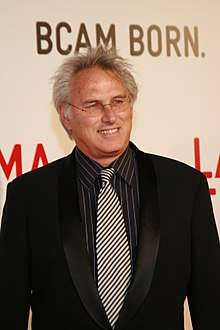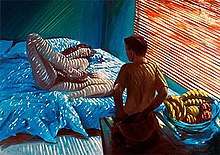Eric Fischl
Eric Fischl (born March 9, 1948) is an American painter, sculptor, printmaker, draughtsman and educator.[1] He is known for his paintings depicting American suburbia from the 1970s and 1980s.[2][3]
Eric Fischl | |
|---|---|
 Fischl, 2008 | |
| Born | March 9, 1948 |
| Nationality | American |
| Alma mater | California Institute of the Arts |
| Known for | Painting, Sculpture, printmaking |
| Movement | Realism, Neo-expressionism |
| Spouse(s) | April Gornik |
Life
Fischl was born in New York City[1] and grew up on suburban Long Island; his family moved to Phoenix, Arizona, in 1967.[4] His art education began at Phoenix College for two years, followed with studying at Arizona State University.[5] Followed by studying at the California Institute of the Arts in Valencia, California, where he received a B.F.A. in 1972.[1] He then moved to Chicago, taking a job as a guard at the Museum of Contemporary Art.
Between 1974 and 1978 he taught at the Nova Scotia College of Art and Design in Halifax, Nova Scotia.[5] It was at this school where he met his future wife, painter April Gornik.[6] In 1978, he moved back to New York City.[1]
Fischl is a trustee and senior critic at the New York Academy of Art[7][8] and President of the Academy of the Arts at Guild Hall of East Hampton.[9] In addition to receiving Guild Hall's Academy of the Art's Lifetime Achievement Award in 1994, Fischl was extended the honor of membership to the American Academy of Arts and Letters in 2006.
Work

Fischl has embraced the description of himself as a painter of the suburbs, not generally considered appropriate subject matter prior to his generation. Some of Fischl's earlier works have a theme of adolescent sexuality and voyeurism, such as Sleepwalker (1979) which depicts an adolescent boy masturbating into a children's pool. Bad Boy (1981) and Birthday Boy (1983) both depict young boys looking at older women shown in provocative poses on a bed. In Bad Boy, the subject is surreptitiously slipping his hand into a purse. In Birthday Boy, the child is depicted naked on the bed.
In 2002, Fischl collaborated with the Museum Haus Esters in Krefeld, Germany. Haus Esters is a 1928 home, designed by Mies van der Rohe in 1928 to be a private home. It now houses changing exhibitions. Fischl refurbished it as a home (though not particularly in Bauhaus style) and hired models who, for several days, pretended to be a couple who lived there. He took 2,000 photographs, which he reworked digitally and used as the basis for a series of paintings,[10] one of which, the monumental Krefeld Redux, Bedroom #6 (Surviving the Fall Meant Using You for Handholds) (2004) was purchased by Paul Allen featured in the 2006 Double Take Exhibit at Experience Music Project, where it was juxtaposed with a much smaller Degas pastel.[11] This is by no means the first time Fischl has been compared to Degas.
Twenty years earlier, reviewing a show of 28 Fischl paintings at New York's Whitney Museum, art critic John Russell wrote in The New York Times, "[Degas] sets up a charged situation with his incomparable subtlety of insight and characterization, and then he goes away and leaves us to figure it out as best we can. That is the tactic of Fischl, too, though the society with which he deals has an unstructured brutality and a violence never far from release that are very different from the nicely calibrated cruelties that Degas recorded."[12]
Fischl also collaborated with Jamaica Kincaid, E. L. Doctorow and Frederic Tuten combining paintings and sketches with literary works.[13]
Personal life
For many years Fischl worked and resided in New York City, with his studio located in Tribeca.[14] In 2000 he moved to Sag Harbor, Long Island, New York with his wife, landscapist April Gornik, where they share a home and matching studios.[15]
References
- Marco Livingstone ([n.d.]). Fischl, Eric. Grove Art Online. Oxford Art Online. Oxford: Oxford University Press. (subscription required).
- "'80s Art Star Eric Fischl on How Artists Can Find Their Second Act". Artspace. Retrieved 2018-04-04.
- "ERIC FISCHL with Robert Berlind". The Brooklyn Rail. Retrieved 2018-04-04.
- Allen, Emma (2014-09-29). "Fender Bender". The New Yorker. ISSN 0028-792X. Retrieved 2018-04-04.
- "Eric Fischl". FAMSF Explore the Art. 2015-05-08. Retrieved 2018-04-04.
- "Saving NSCAD: Why art education could save us, but first we must save it". openDemocracy. Retrieved 2018-04-04.
- Art, New York Academy of. "Senior Critics – New York Academy of Art". nyaa.edu. Retrieved 2017-10-24.
- Ghorashi, Hannah (2016-06-06). "New York Academy of Art Names Four New Trustees, Including Brooke Shields and Naomi Watts". ARTnews. Retrieved 2018-04-04.
- "Guild Hall's Artists-In-Residence Program Receives $15,000 From National Endowment For The Arts". 27East.com. March 29, 2018. Retrieved 2018-04-04.
- Mary Boone Gallery - Eric Fischl's Krefeld Project: Studies, accessed 8 September 2006.
- Christopher Frizzelle, Nightstand: Body Issues, The Stranger, August 31 - September 6, 2006. Accessed online 8 September 2006.
- John Russell, Art at the Whitney, 28 Eric Fischl paintings, The New York Times, February 21, 1986. Accessed online 8 September 2006.
- "Eric Fischl, The Per Contra Interview". Per Contra. September 1, 2006. Archived from the original on July 22, 2011. Retrieved September 8, 2010.
- Bob Colacello (January 2000), Studios by the Sea Vanity Fair.
- Celia McGee (May 15, 2013), A World and an Artist Transformed The New York Times.
Further reading
- Danto, A. C., Enright, R., and Martin, S. (2008). Eric Fischl, 1970-2007. New York: Monacelli Press.